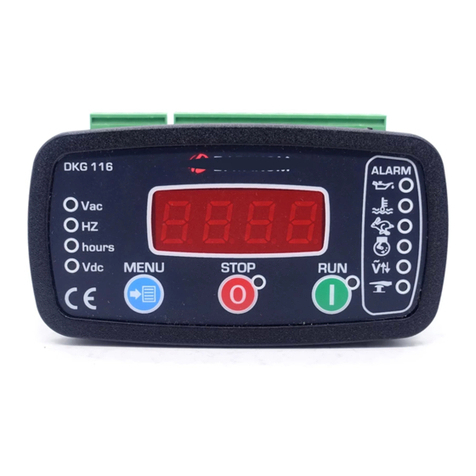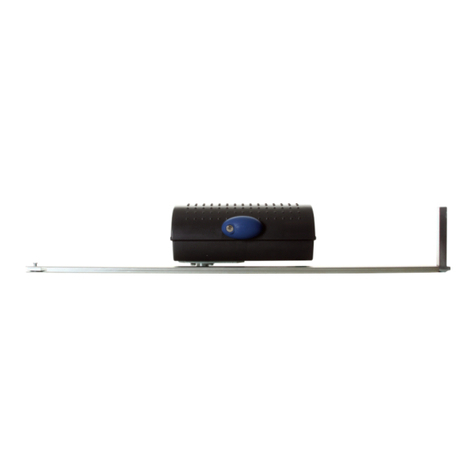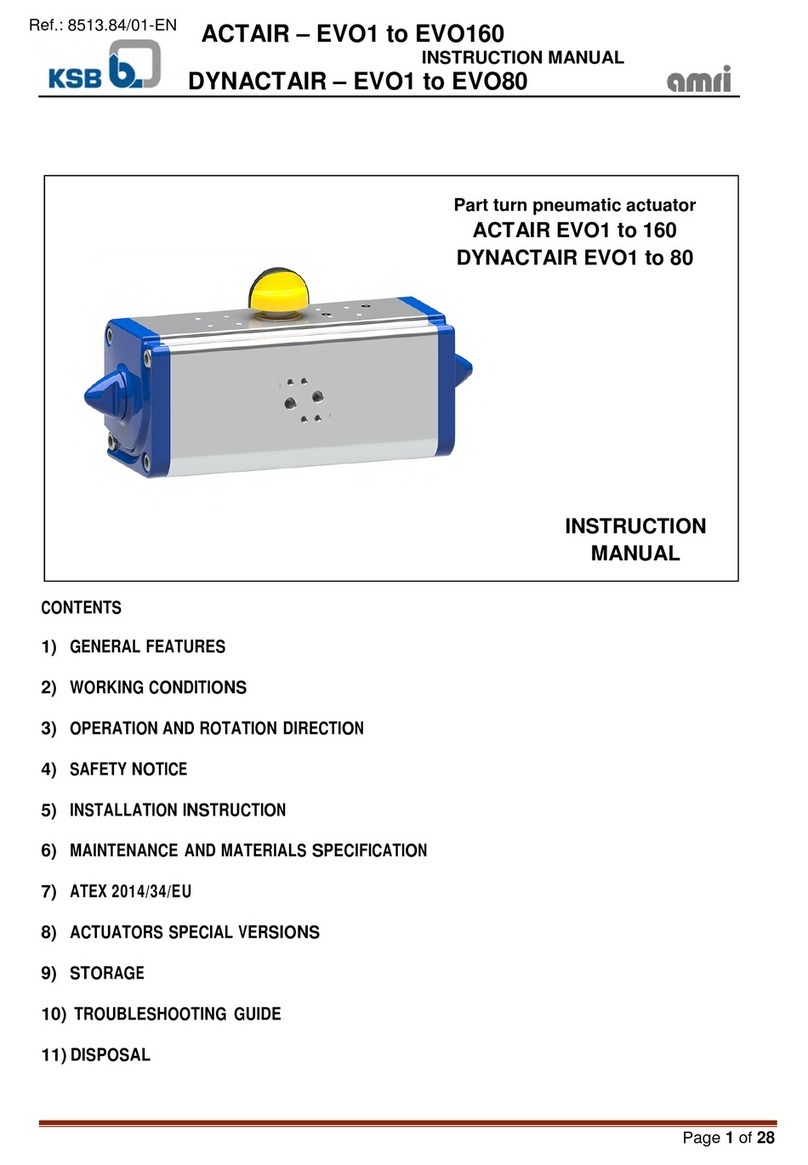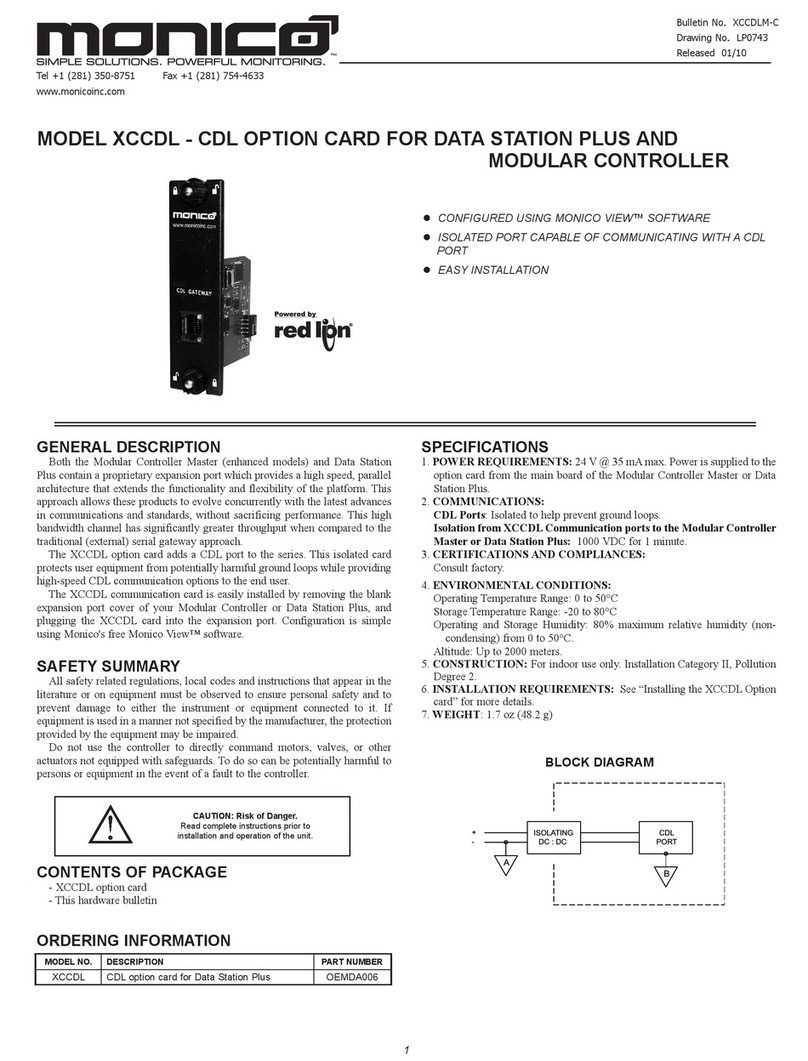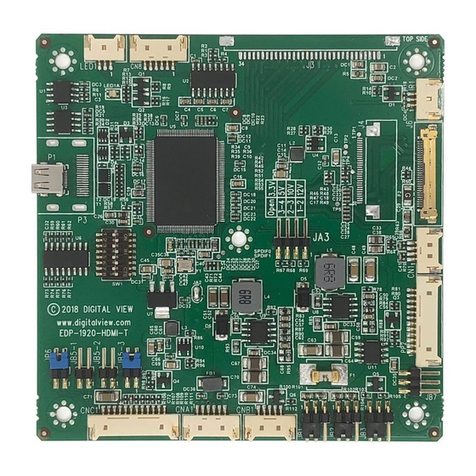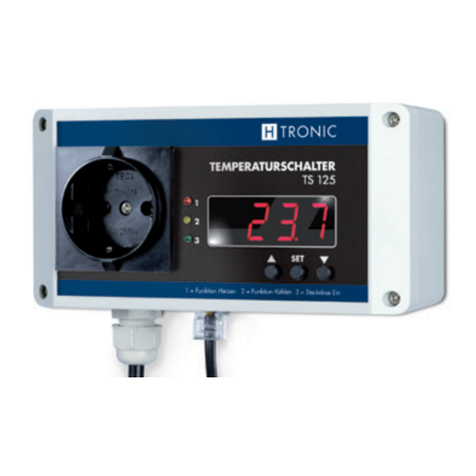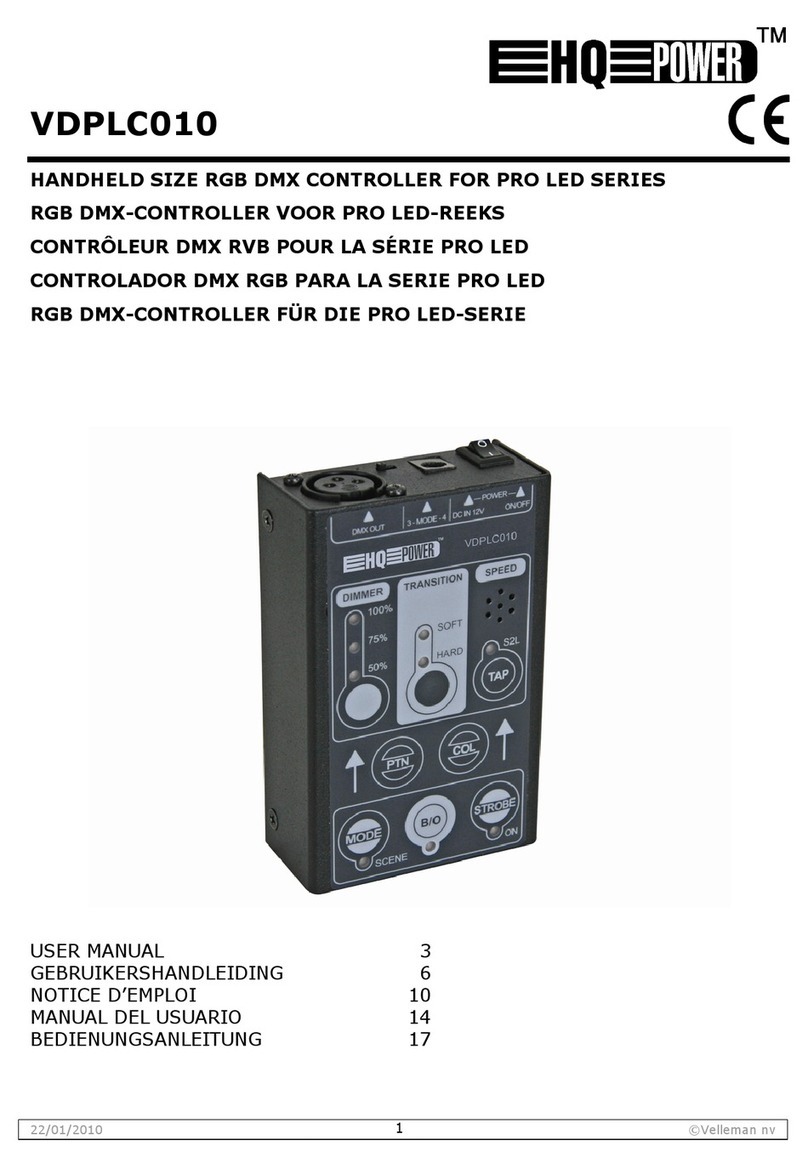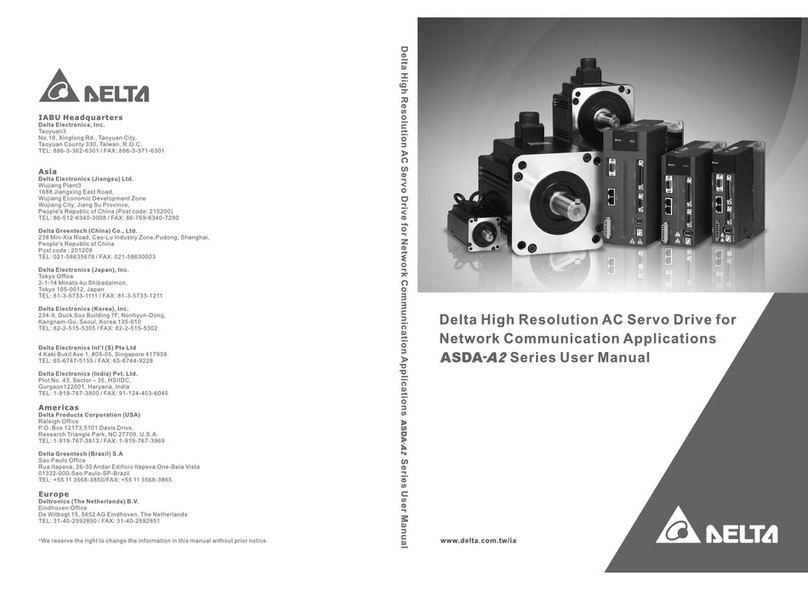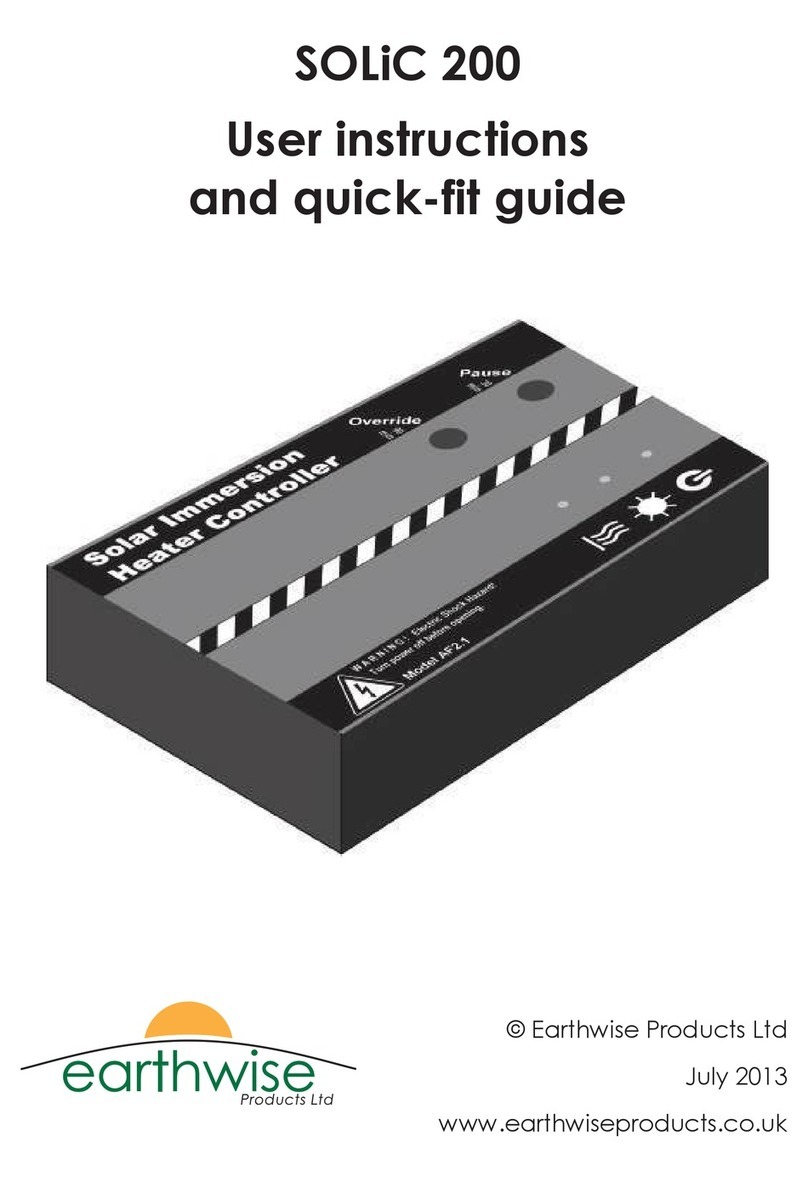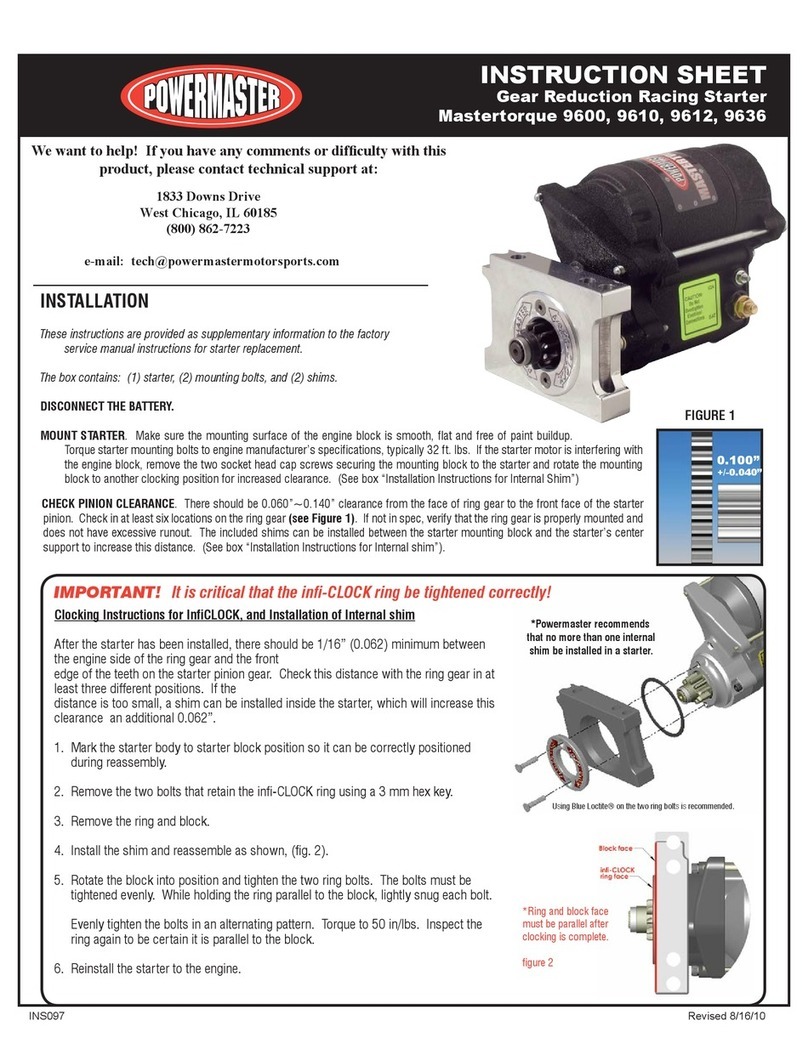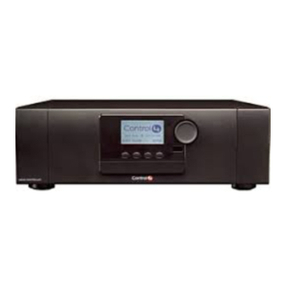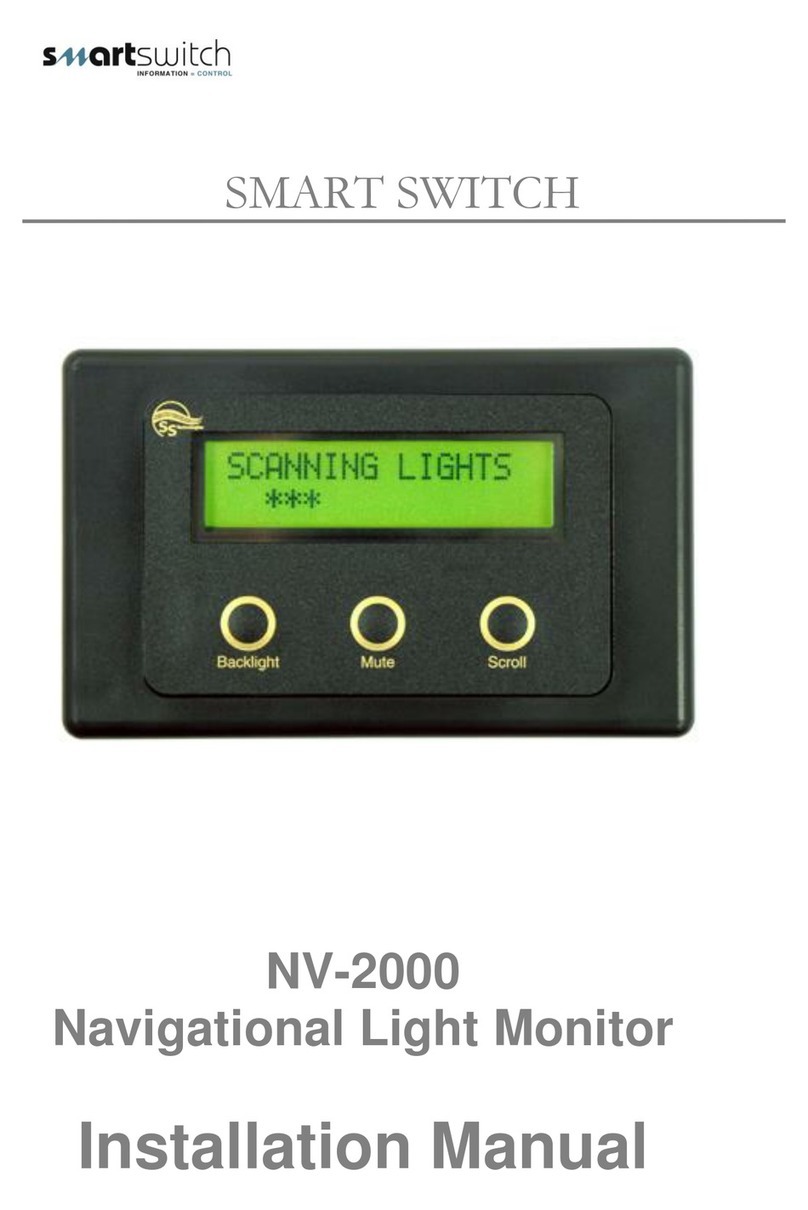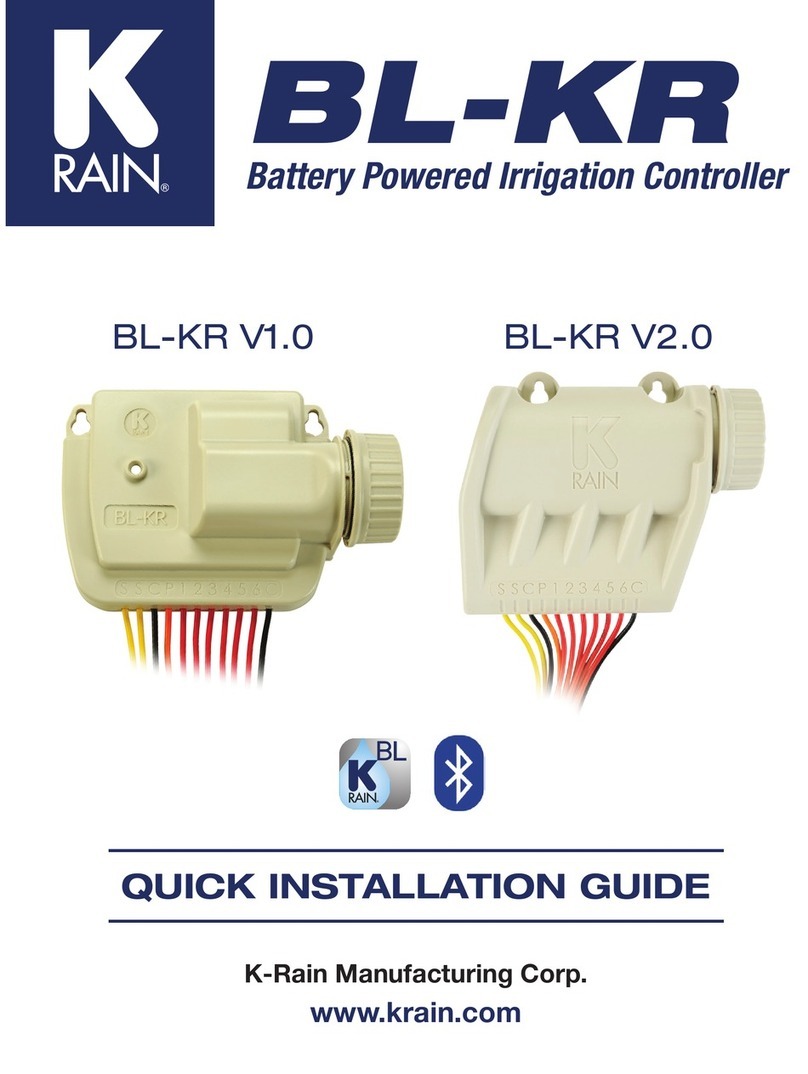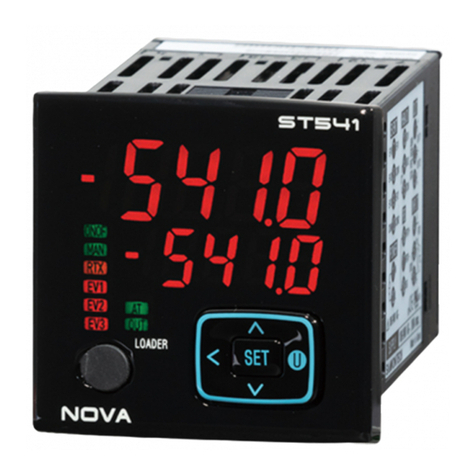Climate Control DXM2.5 Installation guide

DXM2.5 Controls
DXM2.5 Digital
Heat Pump
Controller
Application, Operation
& Maintenance
97B0142N01
Created: October 18, 2022
Table of Contents
Overview 3
Legend and Glossary of Abbreviations 4
Layout and Connections 5
Physical Dimensions and Layout 6
DXM2.5 Controls 7
- Field Selectable Inputs 7
- Dip Switches 7
- Safety Features 9
- Fault Codes 9
- Unit Operation Descriptions 12
- Special DXM2.5 Application Notes/
Accessory Relays 15
- Other Outputs 18
Basic Troubleshooting Information/
Service & Application Notes 20
Conguration and Advanced
Troubleshooting Information 21
- General 21
- System Conguration 21
- Service Mode 22
- DXM2.5 Master/Slave Addressing 22
Functional Troubleshooting Flow Chart 23
Functional Troubleshooting 24
Performance Troubleshooting 27
Revision History 32

WATER-SOURCE HEAT PUMPS
DXM2.5 Unit Control
Created: October 18, 2022
2
This Page Intentionally Left Blank

3
DXM2.5 Unit Control
Created: October 18, 2022
THE SMART SOLUTION FOR ENERGY EFFICIENCY
Overview
The DXM2.5 electronic control is a robust, microprocessor
based heat pump controller that is advanced and feature-
laden for maximum application exibility. The DXM2.5
Control has relay outputs for Compressor, Compressor
Speed, Reversing Valve, Alarm Relay, and 2 congurable
relays for Fan, Fan Speed, HWG Pump, and Loop Pump,
and 2 congurable accessory relay outputs. The DXM2.5
can directly communicate and control a Constant Volume
(CV) ECM blower, internal variable speed water pump,
and modulating water valves. For on board diagnostics,
there are 2 LED’s to provide status indication.
There are inputs for safety pressure switches, low
temperature protection thermistors, condensate overow
sensor, DIP switch selection inputs, thermostat inputs,
night setback inputs, and emergency shutdown input.
Additional congurable temperature sensor inputs are
available that may be used for hot water, compressor
discharge, leaving air, leaving water, and entering water
temperature sensors (except for TRL and Water to Water
products, see product line submittals for details).
The DXM2.5 has an RS485 communications port to
interface with a communicating thermostat or other
communicating controls and tools.
General Operating Parameters: The following are
general operating parameters for the DXM2.5 Control:
• Operating Environment: -40°F to 176°F and up to
95% relative humidity, non-condensing.
• Storage Environment: -40°F to 185°F and up to 95%
relative humidity, non-condensing.
Power Requirements: DXM2.5 only power draw:
• Normally 8 VA draw at 24VAC
• Maximum 12 VA draw at 24VAC. A dedicated
24VAC, 50-60Hz, 1Ph, 40VA transformer minimum is
required for typical WSHP application.
Relay and Connection Contact Ratings: The following
relays are mounted on the DXM2.5 Control:
Compressor Relay: 40VA at 24VAC
• Compressor Speed Relay: 28VA at 24VAC
• Alarm Relay: 28VA at 24VAC
• Reversing Valve: 28VA at 24VAC
• Accessory Relay 1: 28VA at 24VAC
• Accessory Relay 2: 28VA at 24VAC
• Fan Enable / Loop Pump Relay: 1 HP at 240VAC
• Fan Speed / HWG Pump Relay: 1 HP at 240VAC
• Connection ratings on the DXM2.5 Control:
• ‘A’ terminal: 20VA at 24VAC. Larger solenoid valve
draw should be controlled with accessory relays.
Grounding: The control board must be grounded from
one of the C terminals.
Basic Control Features:
• Single or two–stage compressor control
• Anti-short cycle protection
• High pressure cut-out
• Loss of charge cut-out
• Over and under voltage cut-outs
• Water coil low temperature cut-out
• Air coil low temperature cut-out
• Random start
• Status LED and Fault LED
• Reset lockout at unit or disconnect
• Condensate overow sensor
• Intelligent fault retry
• Test Mode
• Multiple blower conguration options
• Electric heat outputs
• Accessory water valve connection
Advanced Control Features:
• Direct control of ECM blower
• Intelligent hot water generator control
• Two accessory relays congurable for multiple
applications
• Variable speed water pump output
• Modulating water valve output
• Night setback with override capability
• Emergency shutdown capability
• Removable thermostat connector for ease of
installation and service
• Accepts conventional heat pump (Y,O) or heat/cool
(Y,W) thermostat types
• RS–485 port to interface with a communicating
thermostat or other communicating controls and tools
• Boilerless electric heat
• Congurable inputs and outputs for advanced functions
• Stores operating conditions history during last 5 faults
and offers possible reasons for faults
• Master/Slave thermostat control of up to 3 units

WATER-SOURCE HEAT PUMPS
DXM2.5 Unit Control
Created: October 18, 2022
4
Legend and Glossary of Abbreviations
Abbreviations Descriptions
BTUH BTU (British Thermal Unit) per hour
CDT Compressor discharge temperature
CFM Airow, cubic feet per minute
COP Coefcient of performance = BTUH output/BTUH input
CT ECM Electronic commutated constant torque fan motor
CV ECM Electronic commutated constant volume fan motor
DB Dry bulb temperature, °F
EAT Entering air temperature
EER Energy efcient ratio = BTUH output/Watt input
ESP External static pressure, inches w.g.
EWT Entering water temperature
FPT Female pipe thread
GPM Water ow in U.S., gallons per minute
HC Air heating capacity, BTUH
HE Total heat of extraction, BTUH
HR Total heat of rejection, BTUH
HWC Hot water generator (desuperheater) capacity, Mbtuh
KW Total power unit input, kilowatts
LAT Leaving air temperature, °F
LC Latent cooling capacity, BTUH
LOC Loss of charge
LW T Leaving water temperature, °F
MBTUH 1,000 BTU per hour
MPT Male pipe thread
MWV Motorized water valve
PSC Permanent split capacitor
SC Sensible cooling capacity, BTUH
S/T Sensible to total cooling ratio
TC Total cooling capacity, BTUH
TD or delta T Temperature differential
VFD Variable frequency drive
WB Wet bulb temperature, °F
WPD Waterside pressure drop, psi or feet of head
WSE Waterside economizer

5
DXM2.5 Unit Control
Created: October 18, 2022
THE SMART SOLUTION FOR ENERGY EFFICIENCY
Layout and Connections
Communicating
Stat Connection
Relays for PSC Blower, CT
ECM Blower, Water Pump,
Hot Water Pump, and
Hot Water Generator
Service Tool
Connection
Conventional
Stat Connection
Communications
and HWG Settings
Accessory relays
refer to DXM2.5 AOM
for conguration
Test Button
to Speed up
Time Delays
Communicating
CV ECM Blower
Connection
Water Coil Low
Temp Limit Setting
JW3-LT1 jumper should
be clipped for low temp
(antifreeze) operation
Factory Low Voltage
Molex Connection
for Unit Harness
Electric Heat
Connection
Use 4 Mounting
Screws – #6 Sheet
Metal Screw 1” Long
24V to Compressor
Second-stage Solenoid
for Y2/Full Load Capacity
VFD or PWM CV ECM Blower
Modulating Valve or
Variable Speed Water Pump
Entering Water Temp
Leaving Water Temp
Leaving Air Temp
Entering Hot Water
Temperature
Compressor Discharge
Temperatrure
Congure Modulating
Valve or Variable
Speed Water Pump

WATER-SOURCE HEAT PUMPS
DXM2.5 Unit Control
Created: October 18, 2022
6
Physical Dimensions and Layout
P1
Alarm
Relay
Comp
Relay
O
Y1
Y2
W
G
C
R
AL1
24Vdc
EH1
EH2
P6
R
C
Off On
JW3
A
OVR
ESD
C
R
NSB
AL2
JW1
Acc1
Relay
Acc2
Relay
H
COM
NC1
NO1
COM
NC2
NO2
P3
CO
RV
RV
LT1
LT1
LT2
LT2
LP
LP
HP
HP
P7
Status
Fault
R
R
CC
CCG
CO
S1
S2
1
12
1
4
Factory Use
(240Vac)
Com
N.O.
Fan Enable
5 1/2"
7" 6 1/2"
5"
Use 4 mounting screws
#6 sheet metal screw 1” long
1.5
3/8” standoff
Factory low
voltage Molex
connection for
unit harness
Factory low
voltage Molex
connection for
electric heat
harness
Micro
U1
Off On
P2
COH
COM
AO2
P11
Gnd T1
P10
T2 T2 T3 T3 T4 T4 T5
P9
T5
T6 T6
A0-1 A0-2
Off On
S3
RV
Relay
CCH
Relay
Test
P5
B-
Gnd
P4
A+ 24V
(240Vac)
Fan Speed
N.O.
N.C.
12V
OUT
Gnd
P8
IN
NC
P12
Note: There is only
one T1 connection
1 2 3 4
1 2 3 4 5 6 7 8
1 2 3 4 5 6 7 8
AO1
Gnd
1

7
DXM2.5 Unit Control
Created: October 18, 2022
THE SMART SOLUTION FOR ENERGY EFFICIENCY
FIELD SELECTABLE INPUTS
Test Mode: Test mode allows the service technician to
check the operation of the control in a timely manner.
By momentarily pressing the TEST pushbutton, the
DXM2.5 control enters a 20 minute test mode period
in which all time delays are sped up 15 times. Upon
entering test mode, the Status and Fault LED displays
will change. The Status LED will either ash rapidly
to indicate the control is in the test mode, or display a
numeric ash code representing the current airow if an
ECM blower is connected and operating. The Fault LED
will display the most recent fault condition in memory.
NOTE: A ash code of 1 indicates there have been no
faults stored in memory.
For diagnostic ease at conventional thermostats, the alarm
relay will also cycle during test mode. The alarm relay will
cycle on and off in sync with Fault LED to indicate a code
representing the last fault, at the thermostat.
The test mode can be exited by pressing the TEST
pushbutton for 3 seconds. The test mode can also be
entered and exited by cycling the G input, 3 times within
60 seconds.
During test mode, the control monitors to see if the
LT1 and LT2 thermistors are connected and operating
properly. If the control is in test mode, the control will
lockout, with Code 9, after 60 seconds if:
a) The compressor is On in Cooling Mode and the LT1
sensor is colder than the LT2 sensor. Or,
b) The compressor is On in Heating Mode and the LT2
sensor is colder than the LT1 sensor.
Retry Mode: If the control is attempting a retry of a fault,
the Fault LED will slow ash (slow ash = one ash
every 2 seconds) to indicate the control is in the process
of retrying.
Field Conguration Options: NOTE: In the following eld
conguration options, jumper wires should be clipped
ONLY when power is removed from the DXM2.5 control.
NOTE: Jumper 3 must not be clipped prior to adding
antifreeze to the water loop. Antifreeze protection to
10°F required. Clipping JW3 without antifreeze may
result in freeze damage and will void the unit warranty.
Water Coil Low Temperature Limit Setting: Jumper
3 (JW3-LT1 Low Temp) provides eld selection of
temperature limit setting for LT1 of 30°F or 10°F [-1°F or
-12°C] (refrigerant temperature).
Not Clipped = 30°F. Clipped = 10°F.
DXM2.5 Controls
Alarm Relay Setting: Jumper 1 (JW1-AL2 Dry) provides
eld selection of alarm function when Alarm Relay is
energized.
Not Clipped = AL1 connected to R (24VAC) with Alarm
Relay active.
Clipped = Dry contact connection between AL1 and AL2
with Alarm Relay active.
JUMPERS (Set at Factory)
A0-2: Congure Modulating Valve or Variable-Speed
Pump (vFlow®Models Only)
Set A0-2 jumper (see Figure on page 5) to “0 - 10v” if
using Internal Modulating Motorized Valve or “PWM” if
using Internal Variable-Speed Pump. This applies only to
vFlow®units with Internal Speed Water Flow Control.
DIP SWITCHES
NOTE: In the following eld conguration options,
DIP switches should only be moved when power is
removed from the DXM2.5 Control to ensure proper
operation.
DIP Package #1 (S1): DIP Package #1 is 8 position
and provides the following setup selections.
DIP 1.1 – Unit Performance Sentinel Disable: Provides
eld selection to disable the UPS feature.
On = Enabled. Off = Disabled.
DIP 1.2 – Compressor Relay Staging Operation:
Provides selection of Compressor Relay staging operation.
The Compressor Relay can be selected to turn on with
Stage 1 or Stage 2 call from the thermostat. This is used
with Dual Stage units (2 compressors where 2 DXM2.5
Controls are being used) or with master/slave applications.
In master/slave applications, each compressor and fan will
stage according to its appropriate DIP 1.2. If set to stage
2, the compressor will have a 3 second on-delay before
energizing during a Stage 2 demand. Also, if set for stage
2, the Alarm Relay will NOT cycle during test mode.
On = Stage 1. Off = Stage 2.
DIP 1.3 – Thermostat Type (Heat/Cool): Provides
selection of thermostat type. Heat Pump or Heat/Cool
thermostats can be selected. When in Heat/Cool Mode,
Y1 is input call for Cooling Stage 1, Y2 is input call for
Cooling Stage 2, W1 is input call for Heating Stage 1,
and O/W2 is input call for Heating Stage 2. In Heat Pump
Mode, Y1 is input call for Compressor Stage 1, Y2 is input
call for Compressor Stage 2, W1 is input call for Heating

WATER-SOURCE HEAT PUMPS
DXM2.5 Unit Control
Created: October 18, 2022
8
DXM2.5 Controls, Cont’d.
Stage 3 or Emergency Heat, and O/W2 is the input call for
RV (heating or cooling dependent upon DIP 1.4).
On = Heat Pump. Off = Heat/Cool.
DIP 1.4 – Thermostat Type (O/B): Provides selection
of thermostat type. Heat pump thermostats with “O”
output on with Cooling or “B” output on with Heating
can be selected.
On = HP Stat with O output with cooling.
Off = HP Stat with B output with heating.
DIP 1.5 – Dehumidication Mode: Provides
selection of normal or Dehumidication Fan Mode. In
Dehumidication Mode, the fan speed will be adjusted
for Cooling. In Normal Mode, the fan speed will be
normal during Cooling.
On = Normal Fan Mode. Off = Dehumidication Mode.
DIP 1.6 – DDC Output at EH2: DIP Switch 1.6 provides
selection for DDC operation. If set to DDC Output at EH2,
the EH2 terminal will continuously output the last fault
code of the controller. If set to EH2 normal, then the EH2
will operate as standard electric heat output.
On = EH2 Normal. Off = DDC Output at EH2.
DIP 1.7 – Boilerless Operation: Provides selection
of Boilerless Operation. In Boilerless Mode, only the
compressor is used for Heating Mode when LT1 is
above the temperature specied by the setting of DIP
1.8. If DIP 1.8 is set for 50°F, then the compressor is
used for heating while LT1 is above 50°F. Below 50°F,
the compressor is not used and the control goes into
Emergency Heat Mode, staging on EH1 and EH2 to
provide heating.
On = normal. Off = Boilerless operation.
DIP 1.8 – Boilerless Changeover Temperature: Provides
selection of boilerless changeover temperature setpoint.
On = 50°F. Off = 40°F.
DIP Package #2 (S2): DIP Package #2 is 8 position
and provides the following setup selections.
DIP Package #2 (S2): A combination of dip switches 2.1,
2.2, 2.3, and 2.4, 2.5, 2.6 deliver conguration of ACC1
and ACC2 relay options respectively. See Tables 1 and 2
for description and functionality.
DIP 2.7 – Auto Dehumidication Fan Mode or High Fan
Mode: Provides selection of Auto Dehumidication Fan
Mode or High Fan Mode. In Auto Dehumidication Mode,
the Fan Speed will be adjusted during Cooling IF the H
input is active. In High Fan Mode, the Fan will operate on
high speed when the H input is active.
On = Auto Dehumidication Mode (default).
Off = High Fan Mode.
DIP 2.8 – Factory Setting: Normal position is On. Do not
change selection unless instructed to do so by the Factory.
DIP Package #3 (S3): DIP Package #3 is 4 position
and provides the following setup selections.
DIP 3.1 – Communications Conguration: Provides
selection of the DXM2.5 operation in a communicating
system. The DXM2.5 may operate as a communicating
master or slave device depending on the network
conguration. In most congurations, the DXM2.5 will
operate as a master device.
On = Communicating Master device (default).
Off = communicating Slave device.
DIP 3.2 – HWG Test Mode: Provides forced operation of
the HWG pump output, activating the HWG pump output
for up to ve minutes.
On = HWG test mode. Off = Normal HWG mode (default).
DIP 3.3 – HWG Temperature: Provides the selection of
the HWG operating setpoint.
On = 150°F [66°C]. Off = 125°F [52°C] (default).
DIP 3.4 – HWG Status: Provides HWG operation control.
On = HWG mode enabled.
Off = HWG mode disabled (default).

9
DXM2.5 Unit Control
Created: October 18, 2022
THE SMART SOLUTION FOR ENERGY EFFICIENCY
DXM2.5 Controls, Cont’d.
Fault Retry: In Fault Retry Mode, the Fault LED begins
slow ashing to signal that the control is trying to recover
from a fault input. The DXM2.5 Control will stage off the
outputs and then “try again” to satisfy the thermostat
call for compressor. Once the thermostat input calls are
satised, the control will continue as if no fault occurred.
If 3 consecutive faults occur without satisfying the
thermostat call for compressor, then the control will go
to Lockout Mode. The last fault causing the lockout will
be stored in memory and is displayed at the Fault LED by
entering the test mode.
NOTE: LT1 and LT2 faults are factory set for one try,
so there will be no “retries” for LT1 and LT2 faults. The
control is factory congured to enter lockout mode
after rst LT1 or LT2 fault.
FAULT CODES
Lockout: In Lockout Mode, the Fault LED will begin fast
ashing. The compressor relay is turned off immediately.
The fan output will be turned off after the current blower
off delay unless auxiliary heat is active. The Lockout Mode
can be “soft” reset via the thermostat by removing the
call for compressor, or by a “hard” reset (disconnecting
power to the control). The fault code will be stored in non-
volatile memory that can be displayed by the Fault LED by
entering the test mode, even if power was removed from
the control.
Lockout with Emergency Heat: If the DXM2.5 is
congured for Heat Pump thermostat mode (see DIP
1.3), the DXM2.5 is in Lockout Mode, and the W input
becomes active, then Emergency Heat Mode will occur
during Lockout. For Emergency Heat, the fan and auxiliary
heat outputs will be activated.
Fault Code 2 – High Pressure Switch: When the High
Pressure switch (HP) opens due to high refrigerant
pressures, the compressor relay is de–energized
immediately. The High Pressure fault recognition is
immediate (does not delay for 30 continuous seconds
before de–energizing the compressor). When the test
mode is activated, the Fault LED will display a fault code
of 2 for a High Pressure fault.
DIP 2.1 DIP 2.2 DIP 2.3 ACC1 Relay Option
ON ON ON Cycle with fan
OFF ON ON Digital night setback
ON OFF ON Water valve – Slow opening
ON ON OFF Outside air damper
OFF ON OFF Dedicated Dehumidication
Mode option – Dehumidistat
OFF OFF OFF Dedicated Dehumidication
Mode option – Humidistat
OFF OFF ON Hydronic Economizer – 1st Stage
ON OFF OFF Hydronic Economizer –
Both Stages
All other DIP combinations are invalid
DIP 2.4 DIP 2.5 DIP 2.6 ACC2 Relay Option
ON ON ON Cycle with compressor
OFF ON ON Digital night setback
ON OFF ON Water valve – Slow opening
OFF OFF ON Humidier
ON ON OFF Outside air damper
OFF OFF ON Hydronic Economizer
OFF ON OFF Hydronic Economizer – 1st Stage
All other DIP combinations are invalid
Table 1: Accessory Relay 1 Conguration
Table 2: Accessory Relay 2 Conguration
⚠
CAUTION!
⚠
CAUTION! Do not restart units without inspection and
remedy of faulting condition. Equipment damage may occur.
SAFETY FEATURES
The following safety features are provided to protect
the compressor, heat exchangers, wiring and other
components from damage caused by operation outside
of design conditions.
Anti-Short Cycle Protection: The control features a 5
minute anti-short cycle protection for the compressor.
NOTE: The 5 minute anti-short cycle also occurs at
power up.
Random Start: The control features a 5-80 second
random start upon power up. The random start delay will
be present after a control power up and after returning
from Night Setback or Emergency Shutdown modes.
Extended Compressor Operation Monitoring: If the
compressor relay has been on for 4 continuous hours,
then the control will automatically turn off the compressor
relay and wait the short cycle protection time. All
appropriate safeties will be monitored during the off time.
If all operation is normal, and if the compressor demand is
still present, the control will turn the compressor back on.

WATER-SOURCE HEAT PUMPS
DXM2.5 Unit Control
Created: October 18, 2022
10
DXM2.5 Controls, Cont’d.
Fault Code 3 – Loss of Charge Switch: The Loss of
Charge Switch (LP) must be open and remain open for 30
continuous seconds during a compressor “on” cycle to be
recognized as a Loss of Charge fault. If the Loss of Charge
switch is open for 30 seconds prior to compressor power
up it will be considered a Loss of Charge fault. The Loss
of Charge Switch input is bypassed for the initial 120
seconds of a compressor run cycle. When the test mode
is active, the Fault LED will display a fault code of 3 for a
Loss of Charge fault.
Fault Code 4 – Water Coil Low Temperature Cut-Out
Limit (LT1): The control will recognize an LT1 fault, during
a compressor run cycle if:
a) The LT1 thermistor temperature is below the selected
low temperature protection limit setting for at least 50
seconds, AND
b) The LT1 thermistor temperature is rising (getting
warmer) at a rate LESS than 2°F every 30 seconds
The LT1 input is bypassed for the initial 120 seconds
of a compressor run cycle. When the test mode is
active, the Fault LED will display a fault code of 4 for a
LT1 fault.
DXM2.5 CONTROLLER FAULT CODES
DXM2.5 Fault and Status LED Operation with Test Mode Not Active Fault LED (Red) Status LED (Green) Alarm Relay
DXM2.5 is non-functional O O Open
Normal operation - No active communications On On Open
Normal operation - With active communications Very Slow Flash On Open
Control is currently in fault retry mode Slow Flash – Open
Control is currently locked out Fast Flash – Closed
Control is currently in an over / under voltage condition Slow Flash –Open
(Closed after 15 Min)
Hot water mode active –Slow Flash Open
(NSB) Night setback condition recognized –Flashing Code 2 –
(ESD) Emergency shutdown condition recognized –Flashing Code 3 –
Invalid thermostat input combination –Flashing Code 4 –
High hot water temperature lockout active –Flashing Code 5 –
Hot water mode sensor fault active –Flashing Code 6 –
DXM2.5 Fault LED and Status Operation with Test Mode Active Fault LED (Red) Status LED (Green) Alarm Relay
No fault since power up in memory Flashing Code 1 –Cycling Code 1
High pressure fault in memory Flashing Code 2 –Cycling Code 2
Low pressure fault in memory Flashing Code 3 –Cycling Code 3
Low temperature protection 1 fault in memory Flashing Code 4 –Cycling Code 4
Low temperature protection 2 fault in memory Flashing Code 5 –Cycling Code 5
Condensate overow fault in memory Flashing Code 6 –Cycling Code 6
Over / Under voltage shutdown in memory Flashing Code 7 –Cycling Code 7
UPS warning in memory Flashing Code 8 –Cycling Code 8
UPT fault in memory / swapped LT1 and LT2 thermistors Flashing Code 9 –Cycling Code 9
ECM airow fault in memory Flashing Code 10 –Cycling Code 10
Test mode active with no ECM connected or operating –Fast Flash –
Test mode active with ECM operating –
Flashing ECM Airow
–
– Fast Flash = 2 ashes every 1 second
– Slow Flash = 1 ash every 2 seconds
– Very Slow Flash = 1 ash every 5 seconds
– Numeric Codes = On pulse 1/3 second; Off pulse 1/3 second followed by a 10 second delay
– ECM Airow = 1 ash per 100 CFM; On pulse 1/3 second; Off pulse 1/3 second followed by a 10 second delay
– Alarm Relay Open = alarm signal off; Alarm Relay Closed = alarm signal on
Table 3: LED and Alarm Relay Output

11
DXM2.5 Unit Control
Created: October 18, 2022
THE SMART SOLUTION FOR ENERGY EFFICIENCY
DXM2.5 Controls, Cont’d.
Fault Code 5 – Air Coil Low Temperature Cut-Out
(LT2): The control will recognize an LT2 fault, during a
compressor run cycle if:
a) The LT2 thermistor temperature is below the low
temperature protection limit setting for at least 50
seconds, AND
b) The LT2 thermistor temperature is rising (getting
warmer) at a rate LESS than 2°F every 30 seconds
The LT2 input is bypassed for the initial 120 seconds
of a compressor run cycle. When the test mode is
active, the Fault LED will display a fault code of 5 for
a LT2 fault.
Fault Code 6 – Condensate Overow: The Condensate
Overow sensor must sense overow levels for 30
continuous seconds to be recognized as a CO fault.
Condensate Overow will be monitored continuously
during the compressor run cycle. When the test mode is
active, the Fault LED will display a fault code of 6 for a
Condensate Overow fault.
Fault Code 7 – Over/Under Voltage Shutdown: An Over/
Under Voltage condition exists when the control voltage
is outside the range of 18VAC to 31.5VAC. Over/Under
Voltage Shutdown is self-resetting in that if the voltage
comes back within range of 18.5VAC to 31VAC for at
least 0.5 seconds, then normal operation is restored.
This is not considered a fault or lockout. If the DXM2.5
is in over/under voltage shutdown for 15 minutes, the
Alarm Relay will close. When the test mode is active, the
Fault LED will display a fault code of 7 for an Over/Under
Voltage Shutdown.
Fault Code 8 – Unit Performance Sentinel - UPS: The
UPS feature warns when the heat pump is operating
inefciently. A UPS condition exists when:
a) In Heating Mode with compressor energized, if LT2 is
greater than 125°F for 30 continuous seconds. Or
b) In Cooling Mode with compressor energized, if LT1
is greater than 125°F for 30 continuous seconds, OR
LT2 is less than 40°F for 30 continuous seconds.
If a UPS condition occurs, the control will immediately go
to UPS warning. The status LED will remain on as if the
control is in Normal Mode. (see “LED and Alarm Relay
Operation Table”). Outputs of the control, excluding Fault
LED and Alarm Relay, will NOT be affected by UPS. The
UPS condition cannot occur during a compressor off cycle.
During UPS warning, the Alarm Relay will cycle on and
off. The cycle rate will be On for 5 seconds, Off for 25
seconds, On for 5 seconds, Off for 25 seconds, etc. When
the test mode is active, the Fault LED will display a fault
code of 8 for an UPS condition.
Fault Code 9 – Unit Performance Test-UPT/Swapped
LT1 & LT2 Thermistors: During test Mode, the control
monitors to see if the LT1 and LT2 thermistors are
connected and operating properly. If the control is in
test mode, the control will lockout, with Code 9, after 60
seconds if:
a) The compressor is On in Cooling Mode and the LT1
sensor is colder than the LT2 sensor. Or,
b) The compressor is On in Heating Mode and the LT2
sensor is colder than the LT1 sensor.
When the test mode is active, the Fault LED will display
a fault code of 9 for a Swapped Thermistor fault.
Fault Code 10 – ECM Blower Fault: When operating
an ECM blower, there are two types of ECM Blower fault
conditions that may be detected.
a) An ECM blower fault will be detected and the
control will lockout after 15 seconds of blower
operation with the blower feedback signal reading
less than 100 RPM.
b) An ECM blower fault will be detected when the ECM
conguration is incorrect or incomplete. For this fault
condition, the control will continue to operate using
default operating parameters.
When the test mode is active, the Fault LED will display
a fault code of 10 for an ECM Blower fault.
Fault Code 11 – Low Air Coil Pressure Switch
(Dedicated Dehumidication Mode Units Only):
When the Low Air Coil Pressure switch opens due
to low refrigerant pressure in the cooling or reheat
operating mode, the compressor relay is de–energized
immediately. The Low Air Coil Pressure fault recognition
is immediate (does not delay for 30 continuous seconds
before de–energizing the compressor). When the test
mode is activated, the Fault LED will display a fault code
of 11 for a Low Air Coil Pressure fault. Note: Low Air Coil
Pressure fault will keep the unit from operating in the
cooling or reheat modes, but heating operation will still
operate normally.
Fault Code 12 – Low Air Temperature (Dedicated
Dehumidication Mode Units Only): The control will
recognize a Low Air Temperature fault, during cooling,
reheat, or constant fan operation if the LAT thermistor

WATER-SOURCE HEAT PUMPS
DXM2.5 Unit Control
Created: October 18, 2022
12
DXM2.5 Controls, Cont’d.
temperature is below 35 degrees for 30 continuous
seconds. When the test mode is activated, the Fault LED
will display a fault code of 12 for a Low Air Temperature
fault. NOTE: Low Air Temperature fault will keep the unit
from operating in the cooling, reheat, or constant fan
modes, but heating operation will still operate normally.
Fault Code 13 – Internal Flow Center Faults: When
operating an internal ow center, the DXM2.5 monitors
the pump feedback signal and may detect one of several
pump faults. The control may detect locked rotor, low
voltage, no ow, or bad pump sensor conditions that will
result in an internal ow center fault. When the test mode
is active, the Fault LED will display a fault code of 13 for
any of these ow center faults.
ESD: The ESD Mode can also be enabled from an
external common signal to terminal ESD (see “Thermostat
Inputs” section for details). For WSHP rooftop products,
ESD (Emergency Shut Down) Mode is utilized when the
ERV (Energy Recovery Ventilator) option is applied to an
TRE series rooftop unit to indicate an ERV fault. A contact
closure at the ERV unit will connect common to the ESD
terminal, which will shut down the rooftop/ERV units. The
green Status LED will ash code 3 when the unit is in
ESD Mode.
Diagnostic Features: The green Status LED and
red Fault LED on the DXM2.5 Control advise service
personnel of the current status of the DXM2.5 Control.
The LED’s will indicate the current operating status of the
DXM2.5, as well as the LAST fault in memory. If there is
no fault in memory and the fault display is selected, the
Fault LED will ash Code 1. See Table 3 for a complete
listing of codes.
UNIT OPERATION DESCRIPTIONS
Power Up: The unit will not operate until all the inputs
and safety controls are checked for normal conditions.
NOTE: The compressor will have a 5-minute anti-short
cycle delay at power-up.
Standby/Fan Only: In Standby Mode, the compressor
will be off. The selected fan output(s) and RV relay
may be on if appropriate inputs are present. If there is
demand for constant fan, the appropriate fan output(s)
will be activated for low speed operation, or constant fan
airow. If there is demand for constant high speed fan, the
appropriate fan output(s) will be activated for high speed
operation, or high speed constant fan airow.
NOTE: DIP1.5 (Dehum Fan Mode Select) has no effect
upon constant fan operation.
The RV relay will not directly track the input demands for
RV, the DXM2.5 Control will employ “smart RV” control.
This ensures that the RV will only switch positions if the
thermostat has called for a Heating/Cooling Mode change.
Heating Stage 1: In Heating Stage 1 Mode, the selected
Fan output(s) and the Compressor relay are turned on
immediately. If congured as Stage 2 (DIP1.2 = off),
then the Compressor and Fan will not turn on until there
is Stage 2 demand. The Compressor relay is turned
off immediately when the Heating Stage 1 demand is
removed. The selected Fan output(s) will turn off after
the selected heating blower off delay, and the control
then reverts to Standby Mode. If there is a Master/Slave
situation or a Dual Compressor situation, all Compressor
relays and related functions will track with their
associated DIP1.2.
Heating Stage 2: In Heating Stage 2 Mode, the selected
Fan output(s) and Compressor relays remain on. The
Compressor Speed relay is turned on, and multi–stage fan
congurations switch to the appropriate operating speed
for Heating Stage 2 immediately. The Compressor Speed
relay is turned off immediately when the Heating Stage 2
demand is removed, and multi–speed fan congurations
switch to the appropriate operating speed for Heating
Stage 1 immediately, and the control reverts to Heating
Stage 1 Mode. For Master/Slave or Dual Compressor
congurations, all Compressor relays and related
functions will track with their associated DIP1.2.
Heating Stage 3: In Heating Stage 3 Mode, the selected
Fan output, Compressor, and Compressor Speed relays
will remain on. The EH1 output will turn on immediately,
and if the control is operating an ECM Blower, the
airow will change to the appropriate Heating Stage 3
airow. With continuing Heating Stage 3 demand, EH2
will turn on after 10 minutes. EH1 and EH2 are turned
off immediately when the Heating Stage 3 demand is
removed, and the control reverts to Heating Stage 2
Mode. During Heating Stage 3 Mode, EH2 will be off
(or will turn off if already on) if LT1 is greater than 45°F
AND LT2 is greater than 110°F (LT2 greater than 110°F
includes the condition that LT2 is shorted). This condition
will have a 30-second recognition time.

13
DXM2.5 Unit Control
Created: October 18, 2022
THE SMART SOLUTION FOR ENERGY EFFICIENCY
DXM2.5 Controls, Cont’d.
Emergency Heat: In Emergency Heat Mode, the selected
fan output(s) will be activated at high speed or the
appropriate airow for Emergency Heat, and EH1 is
turned on immediately. With continuing Emergency Heat
demand, EH2 will turn on after 5 minutes. EH1 and EH2
are turned off immediately when the Emergency Heat
demand is removed. The selected fan output(s) will turn
off after the selected heating blower off delay and the
control reverts to Standby Mode.
Cooling Stage 1: In Cooling Stage 1 Mode, the selected
fan output(s), Compressor, and RV relays are turned
on immediately. If congured as Stage 2 (DIP1.2 = off),
then the compressor and fan will not turn on until there
is Stage 2 demand. The Compressor relay is turned
off immediately when the Cooling Stage 1 demand is
removed. The selected Fan output(s) will turn off after
the selected cooling blower off delay, and the control
then reverts to Standby Mode. The RV relay will remain
on until there is a Heating demand. If there is a Master/
Slave situation or a Dual Compressor situation, all
Compressor relays and related functions will track with
their associated DIP1.2.
Cooling Stage 2: In Cooling Stage 2 Mode, the selected
Fan output(s), Compressor, and RV relays remain on. The
Compressor Speed relay is turned on, and multi–stage
fan congurations switch to the appropriate operating
speed for Cooling Stage 2 immediately. The Compressor
Speed relay is turned off immediately when the Cooling
Stage 2 demand is removed, and multi–speed fan
congurations switch to the appropriate operating speed
for Cooling Stage 1 immediately, and the control reverts
to Cooling Stage 1 Mode. For Master/Slave situation or
dual compressor congurations, all compressor relays and
related functions will track with their associated DIP1.2.
Night Low Limit (NLL) Staged Heating: In NLL Staged
Heating Mode, the OVR input becomes active and is
recognized as a call for Heating (OVR is an alternate
means of calling for Heating Mode). In NLL Staged
Heating Mode, the control will immediately go into
Heating Stage 1 Mode with an additional 30 minutes of
NLL demand, the control will go into Heating Stage 2
Mode. With an additional 30 minutes of NLL demand, the
control will go into Heating Stage 3 Mode.
Blower Congurations: The DXM2.5 may be congured
to operate several different blowers and blower
congurations. The congurations include:
a) No Blower: If the DXM2.5 is congured for no blower
(split system compressor sections), the K1 relay
will become a loop pump relay and the K2 relay will
become a HWG pump relay.
b) 2 Speed PSC Blower: The default conguration of
the DXM2.5 is to operate for a 2 Speed PSC blower,
with the K1 relay operating as a blower enable relay,
and the K2 relay operating as a blower speed relay.
With this conguration, the blower enable relay is
momentarily de-activated when the blower speed
relay is switched. For low speed blower operation
(Constant Fan, Heating 1, Cooling 1, Cooling 2
with Dehumidication), K1 will be active and K2
will be inactive. For high speed blower operation
(High Speed Constant Fan, Heating 2, Heating 3,
Emergency Heat, Cooling 2), K1 and K2 will be active.
c) Constant Volume (CV) ECM Communicating Blower:
If the DXM2.5 is congured for a CV ECM blower, OR
a CV ECM blower is detected, the DXM2.5 will directly
control a CV ECM blower through communiations
using selected or default airows for each operating
mode. When operating a CV ECM blower, the K1
relay becomes a loop pump relay active anytime the
compressor relay is active, and the K2 relay becomes a
HWG pump relay.
d) Single Speed PSC Blower: If the DXM2.5 is congured
for a single speed PSC blower, the K1 relay will operate
as the blower relay, and the K2 relay becomes a HWG
pump relay.
e) 2 Speed Constant Torque (CT) ECM Blower: If the
DXM2.5 is congured for a CT ECM blower, the K1
relay will operate as a blower enable relay, and the
K2 relay will operate as a blower speed relay. The CT
ECM conguration operates like the 2 Speed PSC,
except the blower enable relay is not de-activated
when the blower speed relay is switched.
f) Constant Volume (CV) ECM (PWM) Blower: If the
DXM2.5 is congured for a CV ECM (PWM) blower,
the DXM2.5 will directly control a CV ECM (PWM)
blower through PWM output signal using selected
or default airows for each operating mode. When
operating a CV ECM (PWM) blower, the K1 relay
becomes a loop pump relay active anytime the
compressor relay is active, and the K2 relay becomes
a HWG pump relay.

WATER-SOURCE HEAT PUMPS
DXM2.5 Unit Control
Created: October 18, 2022
14
DXM2.5 Controls, Cont’d.
g) VFD Blower: If the DXM2.5 control is congured for
VFD blower, the DXM2.5 will directly control a VFD
to achieve a target Leaving Air Temperature (LAT) or
at discrete speeds depending on the selected blower
control mode. When operating a VFD, the K1 relay
becomes the VFD enable relay. When the VFD is
off, the output will be set to 0 VDC. If congured for
xed speed blower control, there are maximum and
minimum operating speeds for each operating mode
unique to each unit size.
ECM Blower Operation: When the DXM2.5 is congured
to operate an ECM Blower, or an ECM Blower is
connected to the DXM2.5, the ECM blower will be directly
controlled by the DXM2.5, with advanced operating
features including:.
a) Airow Settings: The DXM2.5 allows the target
airow for each operating mode to be selected
individually, within the allowable operating range.
b) Soft Start Ramping: During the rst 2 minutes of
blower operation during a heating or cooling demand,
the ECM blower will ramp up to the selected target
airow for the current operating mode. For the rst 30
seconds of blower operation, the target airow will
be 50% of the normal target airow. For the next 90
seconds of blower operation, the target airow will
be 75% of the normal target airow. For Constant
Fan, Emergency Heat, and test mode operation, the
Soft Start Ramping prole is bypassed, and the ECM
immediately ramps up to the normal target airow.
c) Blower Off Delays: For ECM blower off delays, the
target airow will be adjusted to 50% of normal target
airow before the beginning of the blower off delay.
d) Default Blower Operation: If the DXM2.5
conguration is incorrect or incomplete with an ECM
Blower connected, the ECM blower will not operate;
an ECM conguration warning will be recognized
while unit is in standby but an airow fault will be
recognized if blower demand is present. Once the
heat pump family, unit size and blower type are
selected, the ECM blower will operate based on the
airow parameters for the current conguration for a
compatible ECM blower of any power level.
Hot Water Generator Operation: When the DXM2.5 is
congured to operate a hot water generator pump, the
pump will be directly controlled by the K2 relay, based
on the S3 DIP switch settings and the T5 (hot water
temperature) and T6 (compressor discharge temperature)
inputs. Hot water generator operating features include:
Thermostat Operating Modes
Mode
Input3Output
O G Y1 Y24W H / DH RV Fan 1st Stg
H/C
2nd Stg
H/C4AUX Reheat
No Demand ON/OFF OFF OFF OFF OFF OFF ON/OFF OFF OFF OFF OFF OFF
Fan Only ON/OFF ON OFF OFF OFF OFF ON/OFF ON OFF OFF OFF OFF
Cooling 1st Stage ON ON ON OFF OFF OFF ON ON ON OFF OFF OFF
Cooling 2nd Stage ON ON ON ON OFF OFF ON ON ON ON OFF OFF
Cooling & Dehumidistat1ON ON ON ON/OFF OFF ON ON ON ON ON/OFF OFF OFF
Dehumidistat Only ON/OFF OFF OFF OFF OFF ON ON ON ON ON OFF ON
Heating 1st Stage OFF ON ON OFF OFF OFF OFF ON ON OFF OFF OFF
Heating 2nd Stage OFF ON ON ON OFF OFF OFF ON ON ON OFF OFF
Heating 3rd Stage OFF ON ON ON ON OFF OFF ON ON ON ON OFF
Heating & Dehumidistat2OFF ON ON ON/OFF ON/OFF ON OFF ON ON ON/OFF ON/OFF OFF
Emergency Heat OFF ON OFF OFF ON OFF OFF ON OFF OFF ON OFF
1 Cooling input takes priority over dehumidication input.
2 DXM2.5 is programmed to ignore a dehumidication demand when the unit is in heating mode.
3 Above inputs assume DIP 1.3 is in the heat pump position, and DIP 1.4 is in the O position. When 1.3 is in the heat/cool position, Y1 and Y2 are used for cooling inputs; W and O are used for
heating inputs. When 1.4 is in the B position, the O column would be opposite logic.
4 N/A for single stage units; Full load operation for dual capacity units.
5 ON/OFF = Either ON or OFF; H/C = Either Heating or Cooling.
Table 4: Thermostat Inputs with Resulting Demands

15
DXM2.5 Unit Control
Created: October 18, 2022
THE SMART SOLUTION FOR ENERGY EFFICIENCY
a) HWG operating setpoint selection (S3–3)
b) Temperature offset verication for efcient HWG
operation
c) HWG test mode (S3–2)
Internal Flow Center [IFC] Operation: When the
DXM2.5 is congured to operate the variable speed
pump in the internal ow controller, the pump will be
directly controlled by the DXM2.5. For controlling the
variable speed pump, the DXM2.5 monitors the entering
water temperature, leaving water temperature, and
pump feedback signal. The pump is controlled in the
following way:
a) Maintain the appropriate temperature difference
across the water coil (EWT–LWT for heating, LWT–
EWT for cooling).
b) Maintain the leaving water temperature below the
appropriate Maximum Heating LWT and above the
Minimum Cooling LWT limits.
Proportional Valve Operation: When the DXM2.5 is
congured to operate a proportional valve, the valve will
be directly controlled by the DXM2.5. For controlling the
proportional valve, the DXM2.5 monitors the entering
water temperature and leaving water temperature. The
proportional valve output will be eneergized 60 seconds
before the compressor relay to establish ow before
the compressor starts. The valve is controlled in the
following way:
a) Maintain the appropriate temperature difference
across the water coil (EWT–LWT for heating, LWT–
EWT for cooling).
b) Maintain the leaving water temperature below the
appropriate Maximum Heating LWT and above the
Minimum Cooling LWT limits.
SPECIAL DXM2.5 APPLICATION NOTES/
ACCESSORY RELAYS
Generally the following applications are based upon
conguring the accessory relays.
Cycle with Fan: If Accessory relay 1 is congured to
“cycle with fan”, Accessory relay 1 will be on any time the
Fan Enable relay, or ECM Blower is on.
Cycle with Compressor: If Accessory relay 2 is
congured to “cycle with compressor”, Accessory relay 2
will be on any time the Compressor relay is on.
DXM2.5 Controls, Cont’d.
Digital Night Setback: If an Accessory relay is congured
for Digital NSB, the Accessory relay will be on any time
the NSB input is connected to Ground “C”.
NOTE: If there are no Accessory relays congured
for Digital NSB, and the DXM2.5 is not connected
to a communicating thermostat congured for
night setback, then the NSB and OVR inputs are
automatically congured for “mechanical” operation.
See Mechanical NSB operation below.
NOTE: Digital Night Setback feature requires a
compatible thermostat. Contact the manufacturer for
information on compatible thermostats.
Mechanical Night Setback: When the NSB input is
connected to Ground “C”, all thermostat inputs (G, Y1, Y2,
W, and O) are ignored. A thermostat setback Heating call
can then be connected to the OVR input. If the OVR input
becomes active, then the DXM2.5 will enter NLL Staged
Heating Mode. NLL Staged Heating Mode would then
provide heating during the NSB period.
Water Valve/Slow Opening: If an Accessory relay is
congured for Water Valve/Slow Opening, the accessory
relay will be energized 60 seconds before the compressor
relay to establish ow before the compressor starts.
Outside Air Damper: If an Accessory relay is congured
for OAD, the Accessory relay will normally turn on any
time the Fan Enable relay is on. But, following a return
from NSB (NSB input no longer connected to Ground “C”)
to Normal Mode, the Accessory Relay will not turn on for
30 minutes even if the Fan Enable Relay is on. After this
30-minute timer expires, the Accessory Relay will turn on
if the Fan Enable Relay is on.
Humidier: If Accessory relay 2 is congured for a
Humidier, the Accessory relay will be on any time the H
input is active.
Hydronic Economizer: If Accessory relay 1 is congured
to be used as a hydronic economizer, normal cooling
operation will be modied.
If Accessory relay 1 is congured as a single stage hydronic
economizer, when a rst stage cooling demand is present
and the H input is active, the accessory relay will be
activated instead of the compressor output. All other heat
pump operating modes will operate normally, and the
accessory relay will be off in all other operating modes.

WATER-SOURCE HEAT PUMPS
DXM2.5 Unit Control
Created: October 18, 2022
16
DXM2.5 Controls, Cont’d.
If Accessory relay 1 is congured as a hydronic
economizer for both stages, when a rst stage cooling
demand is present and the H input is active, the accessory
relay will be activated instead of the compressor output.
When a second stage cooling demand is present with
the H input active, the accessory relay will be activated in
addition to the compressor output. All other heat pump
operating modes will operate normally, and the accessory
relay will be off in all other operating modes.
Dedicated Dehumidication Mode Operation: A heat
pump equipped with the Dedicated Dehumidication
Mode can operate in three modes, cooling, cooling
with condenser water reheat (CWR), and heating.
The cooling/heating modes are like any of our other
WSHP. The reversing valve (“O” signal) is energized
in cooling, along with the compressor contactor(s) and
the selected blower outputs. In the Heating Mode the
reversing valve is de-energized. Almost any thermostat
will activate the heat pump in heating or cooling modes.
The Reheat Mode requires either a separate humidistat/
dehumidistat or a thermostat that has an integrated
dehumidication function for activation. The DXM2.5
board may be congured to work with either a humidistat
or dehumidistat input to terminal “H” (DIP switch
settings for the DXM2.5 board are shown in table 2), or
the manufacturer’s communicating thermostat. Upon
receiving the appropriate “H” input or communicated
signal, the DXM2.5 board will activate the Cooling Mode a
nd engage CWR. Table 5 shows the relationship between
thermostat input signals and unit operation.
Units congured for Dedicated Dehumidication Mode
operation use two additional fault sensors not present
in other unit congurations. The OVR input is used to
monitor a Low Air Coil Pressure switch, and the T4 input
is used for a Leaving Air Temperature sensor, used for low
temperature detection.
Thermostat Inputs: Table 5 shows the resulting demand
from differing combinations of inputs.
Y1: Y1 is the input for compressor stage 1 if DIP1.3 = on.
Y1 is the input for Cooling Stage 1 if DIP1.3 = off.
Y2: Y2 is the input for compressor stage 2 if DIP1.3 = on.
Y2 is the input for Cooling Stage 2 if DIP1.3 = off.
W: If Y1 and Y2 are active and DIP1.3 = on, then W is the
input for Heating Stage 3. If Y1 and Y2 are not active and
DIP1.3 = on, then W is the input for Emergency Heat. If
DIP1.3 = off, then W is the input for Heating Stage 1.
O: O is the input for Reversing Valve Relay if DIP1.3 =
on and DIP1.4 = on. O is the input for Heating Stage 2 if
DIP1.3 = off. O is the input for “Heat Mode” if DIP1.3 = on
and DIP1.4 = off; this means that the thermostat outputs
a “B” call when in Heating Mode and does NOT have
an “O” output. The DXM2.5 Control will employ “Smart
RV” control. This ensures that the RV will only switch
positions if the thermostat has called for a Heating/
Cooling Mode change.
G: G is the input for Constant Fan Operation.
NSB and Override: NSB is the input for Night Setback
Mode. When Digital NSB is selected via the Accessory
Relays DIP switch inputs and the NSB input is connected
to Ground “C”, then the appropriately congured
Accessory Relay is turned on to signal the digital
thermostat to go to Night Setback Setpoints. Stated
differently, when congured for Digital NSB Mode, the
Accessory Relay directly tracks the NSB input.
NOTE: Digital Night Setback feature requires a
compatible thermostat. Contact the manufacturer for
information on compatible thermostats.
When Digital NSB is NOT selected via the Accessory
Relays DIP switch inputs and a communicating
thermostat congured for night setback is not connected,
when the NSB input is connected to Ground “C”, then
Y1, Y2, W, O, and G inputs are ignored. During this time
period, if OVR is momentarily connected to 24VAC, then
Y1, Y2, W, O, and G are once again monitored for 2 hours.
After the 2 hour override period, the DXM2.5 reverts back
to ignoring Y1, Y2, W1, O, and G, assuming the NSB input
is still connected to Ground “C”. There will be a random
start timer when coming back from NSB Mode.
NOTE: The maximum number of DXM2.5 controls
with daisy-chained “NSB” terminals is 75. Also, the
maximum total wire resistance of the “NSB” wiring is
500 Ohms.
OVR: OVR is the input for Night Setback Override or
Night Low Limit Staged Heating input (NLL). When
Digital NSB is NOT selected via the Accessory Relays DIP
switch inputs and a communicating thermostat congured
for night setback is not connected and NSB is connected
to Ground “C”, then if OVR is momentarily connected
to 24VAC (minimum 1 second) then the OVR input is
recognized as a Night Setback Override signal and the
DXM2.5 Control reverts from Night Setback and begins
monitoring thermostat inputs for heating and cooling calls

17
DXM2.5 Unit Control
Created: October 18, 2022
THE SMART SOLUTION FOR ENERGY EFFICIENCY
DXM2.5 Controls, Cont’d.
for a 2 hour override period. If NSB is connected to ground
“C”, then if OVR is continuously connected to 24VAC,
then the OVR input is recognized as a call for NLL Staged
Heating and the control enters NLL Staged Heating.
NOTE: For Dedicated Dehumidication Mode units, the
OVR input is used to monitor a Low Air Coil Pressure
switch, and the normal functions of the OVR input are
not available.
ESD: ESD is the input for Emergency Shutdown Mode.
When the ESD input is connected to Ground “C”, all inputs
are ignored and all outputs are turned off. There will be a
random start timer when coming back from ESD.
H: The H input function is determined by the setting of
DIP2.7, assuming the control is not controlling an internal
ow center or an accessory relay is not congured for
Dedicated Dehumidication Mode or humidier operation.
If DIP2.7 = on then the H input is dened as Automatic
Dehumidication Mode and is used as an “automatic”
counterpart to DIP1.5, meaning if H is connected to
24VAC then the selected fan outputs will operate using
dehumidication speeds and airow settings for cooling.
If H is not connected to 24VAC then the selected fan
outputs will operate using normal speeds and airow
settings for cooling.
If DIP2.7 = off then the H input is dened as High Speed
Fan input and is used as an input to call for High Speed
Fan. If the control is in normal operating modes such
as Standby, Cooling or Heating AND the H input is
connected to 24VAC, then the selected fan outputs will
operate using high speed, or high speed airows (this
operation is a high speed fan version of the G input).
Resulting
Demand #1
(From Table 4)
System Inputs
NSB Type
Resulting
Demand #2
(After ESD, NSB)
ESD NSB OVR
- X - - - ESD
Invalid - - - - Invalid
All
(Excluding Invalid) - - - - All
(Excluding Invalid)
All
(Excluding Invalid) - - M - All
(Excluding Invalid)
C1, C2 - - X - Invalid
OFF, F, H1,
H2, or H3 - - X - NLL Staged
Heating
EH - - X - EH
All
(Excluding Invalid) - X - Mechanical Standby/OFF
All
(Excluding Invalid) - X M Mechanical
All for 2 hours
and then revert
to Standby/OFF
(Excluding Invalid)
C1, C2 - X X Mechanical Invalid
OFF, F, H1,
H2, or H3 - X X Mechanical NLL Staged
Heating
EH - X X Mechanical EH
All
(Excluding Invalid) -X- Digital /
Comm
All
(Excluding Invalid)
All
(Excluding Invalid) - X M Digital /
Comm
All
(Excluding Invalid)
C1, C2 - X X Digital /
Comm Invalid
OFF, F, H1,
H2. or H3 - X X Digital /
Comm
NLL Staged
Heating
EH - X X Digital /
Comm EH
“M” is momentary input
“X” is continuous input
Resulting
Demand #2
(From Table 5)
HAuto Dehum /
F2 DIP 2.7
Resulting
Demand # 3
(After DIP 2.1-2.3, 2.7 Logic)
Standby/OFF X Auto Dehum
Mode Standby/OFF with Auto
Dehum enabled
Standby/OFF X High Fan Mode F2
F1 X Auto Dehum
Mode F1 with Auto Dehum enabled
F1 X High Fan Mode F2
C1 X Auto Dehum
Mode C1 with fan destage
C1 X High Fan Mode *Cooling with High Fan
C2 X Auto Dehum
Mode C2 with fan destage
C2 X High Fan Mode *Cooling with High Fan
H1 X Auto Dehum
Mode H1
H1 X High Fan Mode Heating with High Fan
H2 X - H2
H3 X - H3
EH X - EH
Invalid - - Invalid
* = signies that High Fan is locked on regardless of any Dehum demands
Table 5: System Inputs with the Resulting Demand
Table 5 describes demand changes with differing system input (ESD,
NSB, OVR) and DIP input settings. Resulting Demand #1 is derived
from Table 4.
Table 6: “H” Input with Resulting Demand Modes
Table 6 describes demand changes with “H” input and DIP 2.1-2.3,
and 2.7 settings. Resulting Demand #2 is derived from Table 5.

WATER-SOURCE HEAT PUMPS
DXM2.5 Unit Control
Created: October 18, 2022
18
DXM2.5 Controls, Cont’d.
NOTE: Units with internal ow centers or accessory
relays congured for Dedicated Dehumidication Mode
or humidier operation operate differently from the
above descriptions. For the Dedicated Dehumidication
Mode conguration, the H input is either a humidistat
or dehumidistat (see table 2) input to activate the
Dedicated Dehumidication operating mode. For the
humidier conguration, the H input activates the
humidier output.
OTHER OUTPUTS
Electric Heat: Outputs EH1 and EH2 turn on whenever
the DXM2.5 Control is in the following modes: Heating
Stage 3, Emergency Heat, and Boilerless Operation.
Status LED: The Status LED is green. The Status LED
indicates the operating status of the DXM2.5 Control. See
Table 4: “LED and Alarm Relay Operation”.
Fault LED: The Fault LED is red. The Fault LED displays
the current operating status of the control, or ashes the
corresponding code for the last fault that has occurred
if the test mode is active. If there is no fault in memory,
then the Fault LED will ash Code 1. If the Fault type
is “Primary” (HP, LP, LT1, LT2, or CO) then the Fault
type will always be retained in memory (Primary faults
will overwrite Secondary faults). If the Fault type is
“Secondary” (Over/Under Voltage, UPS or Swapped LT1/
LT2) then the Fault type will only be retained if there are
no “Primary” faults in memory. The Secondary Fault types
will not “overwrite” the Primary fault memory. See Table
4: “LED and Alarm Relay Operation”.
Communications: The DXM2.5 has a single RS485
communications port that provides communication
capabilities for communicating thermostats or connecting
with other communicating controls.
Pressure Switches: All pressure switches are designed
to be normally closed during normal operating conditions,
and to open upon fault.
Condensate Sensor: The Condensate Sensor input will
fault upon sensing impedance less than 100,000 Ohms for
30 continuous seconds. The recommended design uses
a single wire terminated with a male 1/4” quick connect
located in the drain pan at desired trip level. Upon a high
condensate level the water will short between the air coil
and the quick connect producing a resistance less than
100,000 Ohms. Since condensate is free of impurities,
it has no conductivity. Only the impurities from the drain
pan and coil dust or dirt create the conductance. A second
ground wire with appropriate terminal to the drain pan can
be used with the control to replace the air coil ground path.
The Condensate Sensor can also essentially be any open
contact that closes upon a fault condition.
Thermistor Temperature Sensors: The thermistors
used with the DXM2.5 are NTC (negative temperature
coefcient) type. Table 7 shows the replacement part
numbers for the LT1 and LT2 thermistors. The sensors
have a 1% tolerance and follow the characteristics shown
in Table 8. Table 9 shows the nominal resistance at any
given temperature and can be used for eld service
reference. The sensor will use a minimum of 24 AWG wire.
Temp (°F)
Minimum
Resistance
(Ohm)
Maximum
Resistance
(Ohm)
Nominal
Resistance
(Ohm)
78.5 9523 9715 9619
77.5 9650 9843 9746
76.5 10035 10236 10135
75.5 10282 10489 10385
33.5 30975 31598 31285
32.5 31871 32512 32190
31.5 32653 33310 32980
30.5 33728 34406 34065
1.5 80624 82244 81430
0.5 83327 85002 84160
0.0 84564 86264 85410
Table 8: 1% Sensor Calibration Points

19
DXM2.5 Unit Control
Created: October 18, 2022
THE SMART SOLUTION FOR ENERGY EFFICIENCY
Temp (ºC) Temp (ºF) Resistance
(kOhm) Temp (ºC) Temp (ºF) Resistance
(kOhm)
-17.8 0.0 85.34 55 131.0 2.99
-17.5 0.5 84.00 56 132.8 2.88
-16.9 1.5 81.38 57 134.6 2.77
-12 10.4 61.70 58 136.4 2.67
-11 12.2 58.40 59 138.2 2.58
-10 14.0 55.30 60 140.0 2.49
-9 15.8 52.38 61 141.8 2.40
-8 17.6 49.64 62 143.6 2.32
-7 19.4 47.05 63 145.4 2.23
-6 21.2 44.61 64 147.2 2.16
-5 23.0 42.32 65 149.0 2.08
-4 24.8 40.15 66 150.8 2.01
-3 26.6 38.11 67 152.6 1.94
-2 28.4 36.18 68 154.4 1.88
-1 30.2 34.37 69 156.2 1.81
032.0 32.65 70 158.0 1.75
133.8 31.03 71 159.8 1.69
235.6 29.50 72 161.6 1.64
337.4 28.05 73 163.4 1.58
439.2 26.69 74 165.2 1.53
541.0 25.39 75 167.0 1.48
642.8 24.17 76 168.8 1.43
744.6 23.02 77 170.6 1.39
846.4 21.92 78 172.4 1.34
948.2 20.88 79 174.2 1.30
10 50.0 19.90 80 176.0 1.26
11 51.8 18.97 81 177.8 1.22
12 53.6 18.09 82 179.6 1.18
13 55.4 17.26 83 181.4 1.14
14 57.2 16.46 84 183.2 1.10
15 59.0 15.71 85 185.0 1.07
16 60.8 15.00 86 186.8 1.04
17 62.6 14.32 87 188.6 1.01
18 64.4 13.68 88 190.4 0.97
19 66.2 13.07 89 192.2 0.94
20 68.0 12.49 90 194.0 0.92
21 69.8 11.94 91 195.8 0.89
22 71.6 11.42 92 197.6 0.86
23 73.4 10.92 93 199.4 0.84
24 75.2 10.45 94 201.2 0.81
25 77.0 10.00 95 203.0 0.79
26 78.8 9.57 96 204.8 0.76
27 80.6 9.16 97 206.6 0.74
28 82.4 8.78 98 208.4 0.72
29 84.2 8.41 99 210.2 0.70
30 86.0 8.06 100 212.0 0.68
31 87.8 7.72 101 213.8 0.66
32 89.6 7.40 102 215.6 0.64
33 91.4 7.10 103 217.4 0.62
34 93.2 6.81 104 219.2 0.60
35 95.0 6.53 105 221.0 0.59
36 96.8 6.27 106 222.8 0.57
37 98.6 6.01 107 224.6 0.55
38 100.4 5.77 108 226.4 0.54
39 102.2 5.54 109 228.2 0.52
40 104.0 5.33 110 230.0 0.51
41 105.8 5.12 111 231.8 0.50
42 107.6 4.92 112 233.6 0.48
43 109.4 4.72 113 235.4 0.47
44 111.2 4.54 114 237.2 0.46
45 113.0 4.37 115 239.0 0.44
46 114.8 4.20 116 240.8 0.43
47 116.6 4.04 117 242.6 0.42
48 118.4 3.89 118 244.4 0.41
49 120.2 3.74 119 246.2 0.40
50 122.0 3.60 120 248.0 0.39
51 123.8 3.47 121 249.8 0.38
52 125.6 3.34 122 251.6 0.37
53 127.4 3.22 123 253.4 0.36
54 129.2 3.10
Table 9: Nominal Resistance at Various Temperatures
DXM2.5 Controls, Cont’d.

WATER-SOURCE HEAT PUMPS
DXM2.5 Unit Control
Created: October 18, 2022
20
Basic Troubleshooting Information/ Service & Application Notes
General Troubleshooting: Basic DXM2.5 board
troubleshooting in general is best summarized as simply
verifying inputs and outputs. After this process has been
veried, condence in board operation is conrmed and
the trouble must be elsewhere. Below are some general
guidelines required for developing training materials and
procedures when applying the DXM2.5 Control.
DXM2.5 Field Inputs: All conventional inputs are 24VAC
from the thermostat and can be veried using a voltmeter
between C and Y1, Y2, W, O, and G.
Sensor Inputs: All sensor inputs are ‘paired wires’
connecting each component with the board. Therefore
continuity on pressure switches can be checked at the
board connector.
The thermistor resistance should be measured with the
connector removed so that only the impedance of the
thermistor is measured. If desired, this reading can be
compared to the chart shown in the thermistor section
of this manual based upon the actual temperature of
the thermistor clip. An ice bath can be used to check
calibration of a thermistor if needed.
DXM2.5 Outputs: The compressor relay is 24VAC and
can be veried using a voltmeter. The Alarm Relay can
either be 24VAC as shipped or dry contacts (measure
continuity during fault) for use with DDC by clipping
the J4 jumper. Electric heat outputs are 24VDC and
require a voltmeter set for DC to verify operation. When
troubleshooting, measure from 24VDC terminal to EH1 or
EH2 terminals.
Test Mode: Test mode can be entered for 20 minutes
by pressing the Test button. For Diagnostic ease at a
conventional thermostat, the Alarm Relay will also cycle
during test mode.The Alarm Relay will cycle on and off in
sync with the Fault LED to indicate a code representing
the last fault, at the thermostat. Test mode can also be
entered and exited by cycling the G input, 3 times within
60 seconds.
DXM2.5 Thermostat Details
Anticipation Leakage Current: Maximum leakage current
for “Y1” is 50mA and for “W” is 20mA. Triacs can be used
if leakage current is less than above. Thermostats with
anticipators can be used if anticipation current is less than
that specied above.
Thermostat Signals:
• “Y1”, “Y2”, “W”, “O”, and “G” have a 1 second
recognition time when being activated or being
removed.
• “R” and “C” are from the transformer.
• “AL1” and “AL2” originate from the Alarm Relay.
• “A” is paralleled with the compressor output for use
with well water solenoid valves.
Safety Listing: The DXM2.5 Control is listed under UL
873, and is CE listed under IEC 60730.
Table of contents
